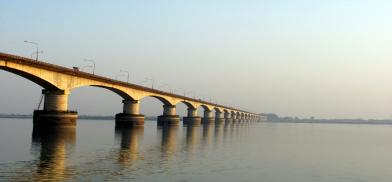Water security in South Asia: Need for ratification of UN water convention
No other country in the world comes close to the hydro-hegemony that China has established. From Pakistan-occupied Kashmir to Myanmar’s troubled Kachin and Shan states, China has widened its dam building to disputed or insurgency-torn areas despite local opposition.

Water security entails society’s ability to provide access to quality water to support livelihoods, health, power generation, and industrial growth. Water is, therefore, becoming an increasingly disputed commodity and a potential geopolitical threat to countries of South Asia where 40 per cent of the world population lives. The transboundary water situation in South Asia is blighted by nationalistic, technocratic, and zealously securitized policies and underlying frameworks (The Asia Foundation, 2014).
South Asia has experienced long-standing poverty, late industrialization, wanton population growth and environmental degeneration and constitutes notable threats to water resources. These threats have multiplied with Chinese ambitions to project itself as a regional water hegemon.
What is hydro-hegemony?
Hydro-hegemony is a new theory that argues that water-sharing, conflicts, and river management between the countries that share transboundary rivers are influenced by their riparian position, power dimensions and exploitation potential. Prominent Indian scholar Brahma Chellaney used the term to explain China’s activity in the upstream that affected India. His pioneering study on the murky water politics in South Asia is mentioned in his book “Water: Asia’s New Battleground.” Six transboundary rivers originate in southwest China and are shared by 12 riparian countries, including those of mainland South Asia—Bangladesh, Bhutan, India, Nepal, and Pakistan. “China’s territorial aggrandizement in the South China Sea and the Himalayas…. has been accompanied by stealthier efforts to appropriate water resources in transnational river basins,” he has stated.
Most areas of South Asia are in a permanent state of water stress as a result of overexploitation, poor management, and climate-change-induced rainfall viability. India and Pakistan are entangled in bilateral disputes over water sharing; Bhutan and Nepal are grappling with poor governance of water resources; and Bangladesh is in a quandary with managing the water flow as it shares 54 rivers with India. Amid this, China has massively invested in water-based resources leading to adverse impacts on the environment, displacement of local people, and huge costs to downstream countries in South Asia. Decisions on water management are unilateral and arbitrary.
And hydro-diplomacy is very much at a nascent stage. Countries see water diplomacy through the lens of sovereignty. The Indus Water Treaty of 1960 between India and Pakistan and the India-Bangladesh Ganges Water Sharing Treaty of 1966 have pushed the limits on these agreements. There has always been a concern over the potential abrogation of the Indus Water Treaty. Pakistan has accused India of utilizing the water from Indus, Chenab and Jhelum for industrial activity in violation of the World Bank-negotiated treaty, a charge that India denies. Water cooperation has also been a controversial issue between India and Nepal where several hydroelectric project agreements have been signed on major rivers such as Kosi, Gandaki and Karnali, and yet there has been little or no execution.
Chinese arm-twisting in South Asia
China refuses to sign any transboundary river agreements saying water exploitation was its sovereign decision. China’s decisions can have a direct impact on the quantity of water available downstream. China upped the ante by planning to construct a mega dam on the Brahmaputra river with utter disregard for ecological fallout and environmental conservation in India's northeastern states, particularly Assam. In June 2020, satellite imagery showed that China had used bulldozers to block the flow of river Galwan, a tributary. In July 2023 it was reported that the construction of the mega dam had begun. It has also not shown any interest in sharing hydro data and sedimentary load data, with India or any other countries.
China has also attempted to exploit its Tibetan Autonomous Region (TAR), which contains a major portion of the world’s fresh water. The official figures reveal that at the end of 2017, the installed hydropower capacity of China reached 341 million kilowatts, while the installed hydropower capacity in the TAR was only 1.77 million kilowatts, accounting for only 1 per cent of the technically exploitable material. (Hangzhou Zhang and Genevieve Donnellon-May, The Diplomat, 1 September, 2021).
China’s rationale in investing in hydropower overseas is a neo-colonial drive to encapsulate resources and materials, both as a part of the Belt and Road Initiative and to fund its GDP growth at the cost of other nations. It is the source of transboundary river flows to the largest number of countries in the world from Russia, Kazakhstan and Kyrgyzstan to the states in South Asia. The water dominance resulted from its absorption of the ethnic homelands that make up 60 percent of its landmass.
China's manipulation of river flows
No other country in the world comes close to the hydro-hegemony that China has established. From Pakistan-occupied Kashmir to Myanmar’s troubled Kachin and Shan states, China has widened its dam building to disputed or insurgency-torn areas despite local opposition. China’s dam building in Myanmar has contributed to blood-fighting and ended a 17-year-old ceasefire between the Kachin Independence Army and the government. For example, the Myitsone dam project was a bone of contention as it was being built at the head of the Irrawaddy confluence of the Mali and N’Mai rivers in Kachin state. It was an environmentally sensitive earthquake-prone area where armed ethnic minority Kachin fighters were battling the Myanmarese army. Many internally displaced ethnic people of Myanmar moved to Myitkyina or found shelter in Maina KBC. The project has been ultimately shelved by both countries.
China has manipulated natural river flows not only for its economic development but to demonstrate its political muscle. Although seeking to promote multilateralism on the world stage, it has given the go-by to multilateral cooperation among river-basin nations symbolized, for instance, by the Mekong River Commission and dismissed efforts by states sharing its rivers to seek bilateral water-sharing arrangements.
Better river basin governance and cooperation
To increase the efficacy of water resource management, South Asia needs proper hydro-political relationships. It means a systematic study of conflicts and cooperation over water resources to avert inevitable threats to regional water security. To create a depoliticized environment where water is equally shared, South Asian countries need to ratify the United Nations Water Convention (The Convention on the Protection and Use of Transboundary Watercourses and International Lakes). It entered into force in 2014. This is a unique platform that aims to ensure the sustainable use of transboundary water resources by facilitating cooperation.
The prerequisites for addressing water security are proactive sharing of hydrological data and information and frequent and targeted dialogues to navigate complexities in the sharing of water. Decades-old conflicts should make headway for cooperation and strategic management which have cascading effects on regional welfare. To facilitate sustainable transboundary water governance, China, an upper riparian country, also needs to sign the UNWC. A tense and uncompromising geopolitical situation will serve no good for South Asia’s hydro-politics.
(The author is an Assistant Professor, Department of Political Science, Jangipur College. Kalyani University, West Bengal. Views are personal. She can be reached at koyelbasu1979@gmail.com)
website yourself or did you hire someone to do it for you?
Plz reply as I'm looking to construct my own blog
and would like to find out where u got this from. thanks
It's a very easy on the eyes which makes it much
more pleasant for me to come here and visit more often. Did you hire out a designer to create your theme?
Superb work!
It's simple, yet effective. A lot of times it's challenging to get that
"perfect balance" between superb usability and visual appeal.
I must say you have done a amazing job with this. Also, the blog loads super quick for me
on Chrome. Excellent Blog!
Exactly where are your contact details though?
a doubt donate to this brilliant blog! I suppose for now i'll settle
for book-marking and adding your RSS feed to my Google account.
I look forward to brand new updates and will talk about
this website with my Facebook group. Chat soon!
I really loved the standard information an individual supply on your
guests? Is gonna be back incessantly to check out new posts
right here. I did however expertise several technical
issues using this web site, since I experienced to reload the web site many times previous to I could get it to load properly.
I had been wondering if your hosting is OK? Not that I'm complaining, but slow loading instances times will often affect your
placement in google and could damage your quality
score if advertising and marketing with Adwords. Well I am adding this RSS to my email and can look
out for much more of your respective fascinating content.
Ensure that you update this again soon.
And he actually bought me dinner simply because I discovered it
for him... lol. So let me reword this.... Thanks for the meal!!
But yeah, thanx for spending some time to discuss this issue
here on your website.
up new blog.
Great website, keep it up!
Bookmarked. Please also discuss with my website =).
We could have a hyperlink alternate arrangement
between us
site and in accession capital to assert that I get actually enjoyed account your blog posts.
Any way I'll be subscribing to your augment and even I achievement you access consistently quickly.
to her ear and screamed. There was a hermit crab inside and
it pinched her ear. She never wants to go back! LoL I know this is
entirely off topic but I had to tell someone!
with the layout on your weblog. Is this a paid theme or did you modify it
yourself? Either way keep up the excellent quality writing, it is rare to see a
nice blog like this one these days.
site, it contains helpful Information.
He was entirely right. This post truly made my day. You cann't imagine just how much
time I had spent for this information! Thanks!
that kind of info written in such a perfect way?
I've a challenge that I am simply now operating on,
and I have been at the look out for such info.
actually enjoyed the standard information an individual provide
in your guests? Is going to be again often to check out new posts
It was truly informative. Your website is very
useful. Thanks for sharing!
South Asia Monitor <Loved it!
message boards that cover the same topics discussed here?
I'd really like to be a part of group where I can get responses from other
knowledgeable individuals that share the same interest.
If you have any suggestions, please let me know. Kudos!
to be totally right. This publish actually made my
day. You can not believe just how so much time I had spent for this information! Thanks!
knew of any user discussion forums that cover the same topics talked about here?
I'd really love to be a part of group where I can get
opinions from other knowledgeable people that share the same interest.
If you have any suggestions, please let me know. Thanks a lot!
drop, just so she can be a youtube sensation. My iPad is now destroyed and she has 83 views.
I know this is completely off topic but I had to share it with someone!
long) so I guess I'll just sum it up what I wrote and say, I'm thoroughly enjoying your blog.
I too am an aspiring blog blogger but I'm still new to everything.
Do you have any tips and hints for newbie blog writers?
I'd really appreciate it.
your time just for this wonderful read!! I definitely liked every little bit of it and i also have you
book-marked to see new stuff in your website.
knew of any message boards that cover the same topics discussed here?
I'd really love to be a part of community where I can get advice from other knowledgeable
individuals that share the same interest. If you have any suggestions, please let me know.
Thanks!
the good work.
Your web site offered us with valuable information to work on. You've done a formidable
job and our entire community will be thankful to you.
You realize a whole lot its almost tough to argue with you (not that I really would
want to…HaHa). You certainly put a new spin on a subject that's been discussed for many years.
Great stuff, just wonderful!
us. Please keep us up to date like this. Thanks for sharing.
Your site provided us with useful information to work on. You
have performed an impressive job and our whole community will be
grateful to you.
article? I'd really love to be a part of group where I can get comments from other knowledgeable individuals that share the same interest.
If you have any recommendations, please let me know.
Thanks a lot!









Post a Comment